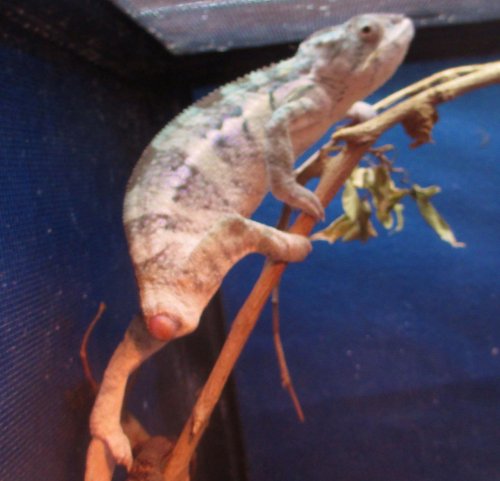Recently, upon returning home, I found this poor chameleon on our doorstep. It was seemingly exhausted and dragged its rear right leg when attempting to move. It looked as though it had gone a couple rounds with a mongoose or perhaps a cat (we have no pets).

I have little to no knowledge of the care of chameleons (other than what I have read about on the net), but would like to be able to return this creature to the wild with a good chance of survival.

You will notice the wounds along the back, on the hip joint of the right rear leg and the severe damage to the tail. I presume the creature is female as the horns are small - though as already mentioned I am no expert. Turns out I really am no expert, she is a male! Corrections made below to avoid confusion.

Steps taken so far:
Environment: Hawaii (Kona) so 80F during the day, 65F at night, cage placed so that a portion gets sun during the day, and the rest is shaded. Outside all the time.He basks daily.
Cage: converted homemade cylindrical open mesh sieve 30" high, 18" diameter with local foliage top to bottom. Separate tank feeding enclosure.
Feeding: Local roaches, flying insects, supplemented with crickets. He will take the roaches as first preference followed by the crickets. He eats once every other day and takes 4 insects per feeding. Each feeding is about 30 minutes long and then he is transferred back to the cage.
Watering: I spray the foliage in the cage while he is eating in the feeding enclosure. He drinks upon returning to the cage.

Handling: None. He is transferred to the feeding enclosure from the cage on a stick, and back again in the same manner.
It is now 5 days later and the chameleon has complete use of all limbs other than her tail. The blackened part of the tail has extended along its length.
My questions are:
1. What else should I be doing (or should have done already)?
2. What is the prognosis for the tail?
3. What are the signs that the creature is ready to be released to the wild?
4. Are there any other details that I need to provide to answer the above?
Thanks in advance for any advice/help that you can provide.

I have little to no knowledge of the care of chameleons (other than what I have read about on the net), but would like to be able to return this creature to the wild with a good chance of survival.

You will notice the wounds along the back, on the hip joint of the right rear leg and the severe damage to the tail. I presume the creature is female as the horns are small - though as already mentioned I am no expert. Turns out I really am no expert, she is a male! Corrections made below to avoid confusion.

Steps taken so far:
Environment: Hawaii (Kona) so 80F during the day, 65F at night, cage placed so that a portion gets sun during the day, and the rest is shaded. Outside all the time.He basks daily.
Cage: converted homemade cylindrical open mesh sieve 30" high, 18" diameter with local foliage top to bottom. Separate tank feeding enclosure.
Feeding: Local roaches, flying insects, supplemented with crickets. He will take the roaches as first preference followed by the crickets. He eats once every other day and takes 4 insects per feeding. Each feeding is about 30 minutes long and then he is transferred back to the cage.
Watering: I spray the foliage in the cage while he is eating in the feeding enclosure. He drinks upon returning to the cage.

Handling: None. He is transferred to the feeding enclosure from the cage on a stick, and back again in the same manner.
It is now 5 days later and the chameleon has complete use of all limbs other than her tail. The blackened part of the tail has extended along its length.
My questions are:
1. What else should I be doing (or should have done already)?
2. What is the prognosis for the tail?
3. What are the signs that the creature is ready to be released to the wild?
4. Are there any other details that I need to provide to answer the above?
Thanks in advance for any advice/help that you can provide.
Last edited:









